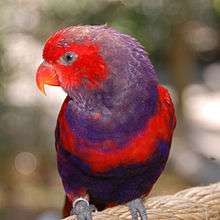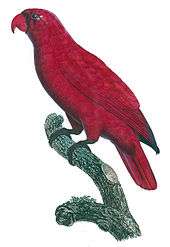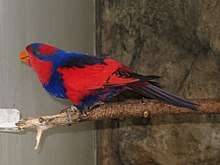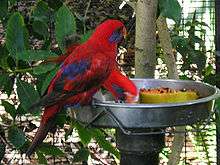Eos (genus)
Eos is a genus of parrots belonging to the lories and lorikeets tribe of the family Psittaculidae. There are six species which are all endemic to islands of eastern Indonesia,[1][2] most within very restricted ranges. They have predominantly red plumage with blue, purple or black markings. Males and females are similar in appearance.
| Eos | |
|---|---|
 | |
| Violet-necked lory (Eos squamata) | |
| Scientific classification | |
| Kingdom: | Animalia |
| Phylum: | Chordata |
| Class: | Aves |
| Order: | Psittaciformes |
| Family: | Psittaculidae |
| Subfamily: | Loriinae |
| Genus: | Eos Wagler, 1832 |
| Species | |
|
6, see text. | |
Their habitats include forest, coconut plantations and mangroves. They gather in flowering trees to feed on nectar and pollen with their brush-tipped tongues. Fruit and insects are also eaten. They make nests in tree hollows generally high in old large trees. Threats to these parrots include habitat loss and trapping for the cagebird trade, and one species, the red-and-blue lory, is classified as endangered.
Description
The plumage of Eos lories is predominantly red, set off with blue, purple or black markings.[1][2] They range in length from 24 cm (9.5 in) in the blue-eared lory[2] to 31 cm (12 in) in several of the larger species.[1][2] The bill is orange-red, the irises are reddish to reddish-brown, and the legs are grey. Males and females are identical in external appearance.[3] They have a musky odour, especially noticeable in the black-winged lory, which is retained even in museum skins.[4] Juvenile birds are partly striated owing to feathers with darker or dusky tips,[1][4] and they have orange-brown to black beaks.[1]
Species in the genus Eos are distinguished from lories in the genus Chalcopsitta by shorter tails and the absence of a bare patch of skin around the mandibles.[4] Members of Eos do not have green plumage, which helps to distinguish them from some species of other lory genera.[3]
Eos (Ἔως) is Greek for "dawn", referring to the red plumage.
Behaviour and ecology
The Eos lories feed on the nectar and pollen of various trees and plants. Very little is known about the diet of most species, but birds have been observed feeding on the flowers of coconuts, Eugenia, coral trees (Erythrina), Canarium, and sago palm (Metroxylon). In addition, they have been observed feeding on unripe fruits of fig trees (Ficus), and insects have been found in the stomachs of at least one species (the red lory). Some species are reported to be nomadic, moving between islands within their range in order to find food. These movements can apparently be daily as well, with the violet-necked lory making daily trips from its main islands to smaller offshore islands.[5]
The Eos lories are apparently seasonal breeders, with birds prospecting for nesting sites varying by species, having been observed in June and July in the black-winged lory but August and September in the red lory. Like most parrots, they are cavity nesters, generally nesting high in older large trees either in forests or in modified habitats. Most of what is known about their nesting behaviour is derived from captive birds. They generally have a clutch size of two eggs which are incubated for 26–27 days. Chicks take around 75–87 days to fledge.[5]
Status and conservation

Threats to these parrots include habitat loss and trapping for the cagebird trade. For example, between 1983 and 1989 an average of 3,200 red lories were trapped and exported per year, which has apparently led to declines in some parts of its range.[5] The red-and-blue lory is an endangered species,[6] and the black-winged lory is classed as vulnerable.[7] The red-and-blue lory is listed under Appendix I of CITES,[8] banning all trade in wild caught birds,[5] while all other species are listed under Appendix II and require permits for their trade.
Taxonomy
The genus Eos was introduced by the German naturalist Johann Georg Wagler in 1832.[9] The type species was subsequently designated as the red-and-blue lory (Eos histrio) by the English zoologist George Robert Gray in 1840.[10] The genus name is from the Ancient Greek eōs meaning "dawn".[11]
The closest relatives of this genus are the species in the genus Trichoglossus.[12][13] The genera Eos, Trichoglossus, Chalcopsitta, and Pseudeos form a single clade within the lories and lorikeets.[12][13] The cardinal lory (Chalcopsitta cardinalis) has sometimes been placed in the genus.[14]
The genus Eos has six species and several subspecies:[15]
Eos, Wagler 1832
- Red-and-blue lory, Eos histrio, (Statius Muller 1776)
- Eos histrio challengeri, Salvadori 1891
- Eos histrio histrio, (Statius Muller 1776)
- Eos histrio talautensis, Meyer, AB & Wiglesworth 1894
- Violet-necked lory, Eos squamata, (Boddaert 1783)
- Eos squamata obiensis, Rothschild 1899
- Eos squamata riciniata, (Bechstein 1811)
- Eos squamata squamata, (Boddaert 1783)
- Red lory, Eos bornea (Linnaeus 1758)
- Eos bornea bornea, (Linnaeus 1758)
- Eos bornea cyanonotha, (Vieillot 1818)
- Blue-streaked lory, Eos reticulata, (Muller, S 1850)
- Black-winged lory, Eos cyanogenia, Bonaparte 1850
- Blue-eared lory, Eos semilarvata, Bonaparte 1850
Species details
| Species of Eos in taxonomic sequence | |||
|---|---|---|---|
| Common and binomial names[15] | Image | Description | Range |
| Red-and-blue lory (Eos histrio) |
 |
31 cm (12 in) long. Mostly red and blue, with some black on wings and thighs. Blue back and breast. Red above beak. Band of blue plumage over the mid-crown is continuous with blue around the eyes and blue bands that extend downwards to join blue on the back.[2][16] | Several subspecies; Talaud Islands, (including the Nanusa Islands), and Sangir Islands of Indonesia[2][6] |
| Violet-necked lory (Eos squamata) |
 |
27 cm (11 in) long. Mostly red and blue with a blue abdomen. Extent of blue neck collar depends on subspecies. Red and black in wings. Purple-red tail.[1] | Several subspecies; western Papuan Islands and North Moluccas of Indonesia[1][17] |
| Red lory (Eos bornea) |
_Jurong_Bird_Park2-3c.jpg) |
31 cm (12 in) long. Mostly red and upper body is all red. Red, blue and black markings on back and wings.[2] | Several subspecies on islands from South Moluccas to Kai Islands, Indonesia[2][18] |
| Blue-streaked lory (Eos reticulata) |
.jpg) |
31 cm (12 in) long. Mostly red with blue streaking over back, and red and black in wings and tail. Blue plumage extends from eyes over ears and partly down neck.[1] | Yamdena and Larat of the Tanimbar Islands and also on Babar of the Babar Islands, Indonesia[19] |
| Black-winged lory (Eos cyanogenia) |
 |
31 cm (12 in) long.[1] Mostly red with blue plumage around eyes extending back over ears. Black on back, wings, and thighs.[1][20] | Geelvink Islands, Papua (formerly Irian Jaya), Indonesia[7][20] |
| Blue-eared lory (Eos semilarvata) |
 |
24 cm (9.4 in) long. Mostly red with blue underparts. Blue plumage extends under chin, under eyes, and part way down side of head and neck. Red, blue, and black in wings.[2] | Seram, Indonesia[2][21] |
References
- Forshaw (2006). plate 8.
- Forshaw (2006). plate 9.
- Forshaw (2006). page 28.
- Low (1978), p.51
- Collar (1997) pages 341-343
- BirdLife International (2008). "Eos histrio". IUCN Red List of Threatened Species. 2008. Retrieved 20 February 2009.CS1 maint: uses authors parameter (link) CS1 maint: ref=harv (link)
- BirdLife International (2008). "Eos cyanogenia". IUCN Red List of Threatened Species. 2008. Retrieved 20 March 2009.CS1 maint: uses authors parameter (link) CS1 maint: ref=harv (link)
- "Appendices I, II and III". CITES. 1 July 2008. Archived from the original on 2008-11-16.
- Wagler, Johann Georg (1832). "Monographia Psittacorum". Abhandlungen der mathematisch-physikalischen Classe, Königlich-Bayerische Akademie der Wissenschaften. 1: 463–750 [494].
- Gray, George Robert (1840). A List of the Genera of Birds : with an Indication of the Typical Species of Each Genus. London: R. and J.E. Taylor. p. 52.
- Jobling, James A. (2010). The Helm Dictionary of Scientific Bird Names. London: Christopher Helm. p. 147. ISBN 978-1-4081-2501-4.
- Wright, T.F.; Schirtzinger, E. E.; Matsumoto, T.; Eberhard, J. R.; Graves, G. R.; Sanchez, J. J.; Capelli, S.; Muller, H.; Scharpegge, J.; Chambers, G. K.; Fleischer, R. C. (2008). "A Multilocus Molecular Phylogeny of the Parrots (Psittaciformes): Support for a Gondwanan Origin during the Cretaceous". Mol Biol Evol. 25 (10): 2141–2156. doi:10.1093/molbev/msn160. PMC 2727385. PMID 18653733.
- Astuti, Dwi; Azuma, Noriko; Suzuki, Hitoshi; Higashi, Seigo (2006). "Phylogenetic relationships within parrots (Psittacidae) inferred from mitochondrial cytochrome-b gene sequences". Zoological Science. 23 (2): 191–198. doi:10.2108/zsj.23.191. hdl:2115/54809. PMID 16603811.
- Forshaw (1978), p. 50
- "Zoological Nomenclature Resource: Psittaciformes (Version 9.020)". www.zoonomen.net. 2009-03-20.
- "Species factsheet: Eos histrio". BirdLife International (2008). Retrieved 21 March 2009.
- BirdLife International 2008. Eos squamata. 2008 IUCN Red List of Threatened Species. Archived June 27, 2014, at the Wayback Machine Downloaded on 20 March 2009.
- BirdLife International 2008. Eos bornea. 2008 IUCN Red List of Threatened Species. Archived June 27, 2014, at the Wayback Machine Downloaded on 20 March 2009.
- BirdLife International (2008). "Eos reticulata". IUCN Red List of Threatened Species. 2008. Retrieved 20 March 2009.CS1 maint: uses authors parameter (link) CS1 maint: ref=harv (link)
- "Species factsheet: Eos cyanogenia". BirdLife International (2008). Retrieved 20 March 2009.
- BirdLife International (2008). "Eos semilarvata". IUCN Red List of Threatened Species. 2008. Retrieved 20 March 2009.CS1 maint: uses authors parameter (link) CS1 maint: ref=harv (link)
- Arndt, Thomas (2007) Lexicon of Parrots. Accessed 31/07/07.
Cited texts
- Collar N (1997) "Family Psittacidae (Parrots)" in Handbook of the Birds of the World Volume 4; Sandgrouse to Cuckoos (eds del Hoyo J, Elliott A, Sargatal J) Lynx Edicions:Barcelona. ISBN 84-87334-22-9
- Forshaw, Joseph M. (2006). Parrots of the World; an Identification Guide. Illustrated by Frank Knight. Princeton University Press. ISBN 0-691-09251-6.
- Forshaw, Joseph M.; Cooper, William T. (1981) [1973, 1978]. Parrots of the World (corrected second ed.). David & Charles, Newton Abbot, London. ISBN 0-7153-7698-5.
- Low, Rosemary. (1978). Lories and Lorikeets. The Brush-Tongued Parrots. Inkata Press: Melbourne. ISBN 0-909605-08-4.